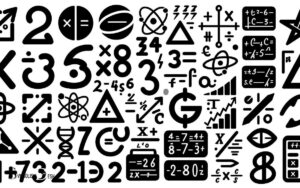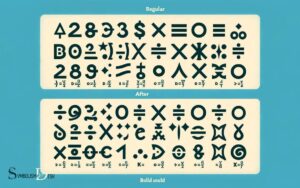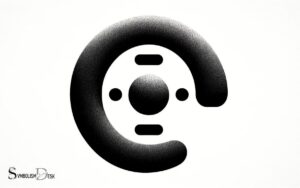I Love You in Math Symbols: Explain!
“I Love You” expressed through mathematical symbols can be a creative and intellectual way of showcasing affection. By utilizing equations and notations from various branches of mathematics, one can symbolize this powerful sentiment in a unique manner.
Mathematics, often seen as the language of the universe, can also be used to represent love. Here are some examples: –
Algebraically:
- “I <3 U” could be written using the inequality “I < 3 U,” playing on the heart symbol’s resemblance to the number 3 and the less-than sign.
- In geometry, a heart shape can be modeled with equations for curves.
- Using calculus, one might integrate small pieces of love over time to show growing affection.
- Trigonometric functions can graph heart shapes on a polar coordinate system.
Mathematics transcends languages, allowing love to be conveyed in an intellectually universal way.

Key Takeaway
Expressing Love With Algebraic Equations
In mathematics, expressing love through algebraic equations can be achieved by utilizing a combination of variables, constants, and mathematical operations.
By assigning variables to represent different aspects of love, such as time spent together, shared experiences, or mutual feelings, it becomes possible to create equations that encapsulate the essence of love.
Constants can be used to represent unchanging aspects, such as foundational values or unwavering commitments.
Mathematical operations then allow for the manipulation of these variables and constants, enabling the expression of intricate and nuanced emotions.
Through this method, love can be quantified and analyzed, offering a unique perspective on the complexities of human emotion.
This approach not only showcases the versatility of mathematical language but also highlights the potential for interdisciplinary connections between mathematics and human experiences.
Conveying Affection Through Trigonometric Functions
Conveying affection through trigonometric functions involves a precise mathematical representation of emotional connections. This method allows individuals to express love and affection using the language of mathematics.
Here are three ways in which trigonometric functions can be used to convey feelings:
- Sine Function: The oscillatory nature of the sine function can represent the ebb and flow of emotions within a relationship, symbolizing the ups and downs that come with love.
- Cosine Function: The repetitive and cyclical nature of the cosine function can symbolize the enduring and timeless aspects of love, highlighting its constancy and stability.
- Tangent Function: The steep and unbounded nature of the tangent function can represent the intensity and passion often associated with romantic love, capturing the fervor and excitement of affectionate connections.
Symbolic Representation of Love in Calculus
The symbolic representation of love in calculus expands upon the three previously discussed ways of conveying affection through trigonometric functions. In calculus, love can be represented through equations that capture the essence of passion and connection.
One such example is the use of parametric equations to represent the path of two individuals in love. The motion of these individuals can be described using calculus, showcasing the beauty of their relationship through mathematical expressions.
Another example is the concept of limits, where love is depicted as an unending, infinite bond between two people. Furthermore, the derivative of a love function can reveal the rate of change of affection over time.
This symbolic representation of love in calculus provides a unique perspective on expressing deep emotions through mathematical concepts.
| Love Symbol | Calculus Representation |
|---|---|
| Parametric Equations | Path of two individuals in love |
| Limits | Unending, infinite bond between two people |
| Derivative | Rate of change of affection over time |
Geometric Interpretations of ’I Love You
With an emphasis on geometric interpretations, the concept of ‘I Love You’ can be viewed through mathematical constructs that capture spatial relationships and symbolic significance.
When exploring geometric interpretations of ‘I Love You’, we can consider:
- Heart Shape: The traditional symbol of love, the heart shape, can be represented mathematically using curves and conic sections, such as the equation for a cardioid or an ellipse.
- Golden Ratio: The golden ratio, often denoted by the Greek letter phi (φ), is a geometric proportion that has been associated with beauty and aesthetics, and can be found in various natural formations, including flowers and shells.
- Three-Dimensional Forms: Love can also be represented through three-dimensional geometric shapes, such as the intertwining of two Möbius strips to symbolize the unity and inseparability of love.
The Beauty of Love in Mathematical Notations
Mathematical notations offer a unique lens through which to appreciate and express the profound beauty of love. In mathematics, the elegance and precision of symbols can capture the complexities of human emotions. For example, equations and formulas can be used to represent the depth of a person’s feelings or the interconnectedness of two individuals. In fact, some people even use ‘birthday math symbols‘ to create personalized equations that encapsulate the significance of a special date or event in their relationship. By leveraging mathematical notations, individuals can articulate and celebrate the depth and uniqueness of their love in a truly meaningful way.
Equations, such as those describing the graceful curves of a heart, can symbolize the interconnectedness and harmony found in loving relationships.
The symmetry and balance in mathematical notations mirror the equilibrium and mutual support that are integral to enduring love. Furthermore, the infinite nature of numbers parallels the boundless depth of love, which knows no limits.
The use of mathematical notations to represent love underscores the universality and transcendental quality of this profound emotion, revealing that love, like mathematics, is a language that transcends cultural and linguistic boundaries.
Conclusion
The use of mathematical symbols to express love showcases the beauty of precision and logic in conveying emotions. From the infinite nature of π representing endless affection to the equality sign signifying balance and harmony in relationships, these representations bridge the abstract with the tangible. Symbols in math, though often associated with calculations, can powerfully capture the depth and intricacy of human connections. In this way, mathematics becomes not just a tool for computation but a language for expressing the profound and universal essence of love.
The symbolic representation of love in algebraic equations, trigonometric functions, calculus, and geometric interpretations highlights the complexity and depth of affection. It is a clever and creative way to demonstrate the universal language of love through the lens of mathematics.






